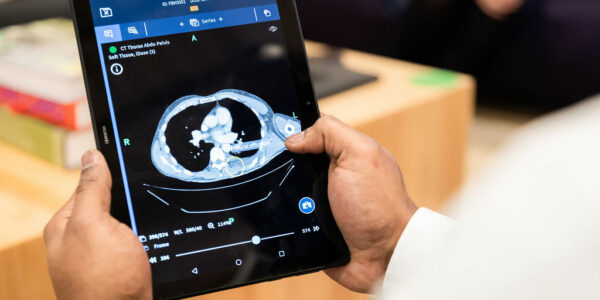CareLocker launched enhancing Bleepa technology
09/09/21
CareLocker is a new proprietary and patient-centric cloud architecture that supports Bleepa’s functionality whilst simultaneously creating patient specific records of care episodes. CareLocker will enable Bleepa to support care delivery across provider settings in a secure and scalable way.
CareLocker + Bleepa

Bleepa provides practitioners with mobile access to patient data, including medical images, allowing secure communication and on-the-go decision making. As a clinical tool Bleepa integrates with multiple hospital systems and centralises relevant clinical data around specific patient episodes, from which clinical teams can accelerate decision making capabilities through the platform.
This data includes lab results, structured reports, ECGs and most importantly medical images, which are uniquely displayed through Bleepa’s regulated DICOM viewer. CareLocker provides a patient-centric way of storing data and because the patient record is de-centralised, they can be accessed by any care setting through open Application Programming Interfaces (APIs) such as FHIR.
Patient-centric cloud data storage
CareLocker provides patient-centric cloud data stores: containers that store medical data at an individual patient level. With this proprietary architecture, patient data can be secured at the individual level, with access control even to subsets of a patient’s data. CareLocker offers opportunities for improved storage optimisation making it more cost effective than traditional data storage architectures.
Most importantly, CareLockers can be built on a patient-by-patient basis, allowing organisations to transition to a cloud architecture as patients enter care pathways rather than having to undertake the mass data migrations usually associated with cloud transitions.
Supporting community diagnostic hubs
Where Bleepa is installed in multiple regional provider settings, the migration of data into a patient specific record can happen at a regional level, breaking down provider siloes. One topical area of application is in facilitating the £10bn Community Diagnostic Hub (CDH) initiative launched by NHS England to help address the elective care backlog by bringing diagnostic services out of hospital settings and closer to patients.
CDHs will typically complete a suite of diagnostic tests, the results of which must all be made available to the clinical teams, both in the primary and secondary care setting, creating a patient pathway that bridges multiple care settings. This end-to-end patient-specific pathway requires a digital infrastructure designed to both connect clinical teams and manage the associated data flow. Bleepa and CareLocker in combination provide this, with Bleepa as an application and user interface and CareLocker as the underlying data architecture.
Find out more about CareLocker in our interview with Feedback Medical CEO, Dr Tom Oakley.
Dr Tom Oakley, CEO, said: “CareLocker is the latest development in the Bleepa story and has the potential to be a significant catalyst to multiple commercial opportunities. We have been working on this concept for many months in order to position Bleepa for multi-site adoption and to meet the emerging needs of the CDH initiative to address the elective care backlog. Currently patient data is siloed within disparate hospital systems and within individual clinical settings, this makes delivering regional care extremely difficult. In some cases it can take hours to transfer imaging between two hospitals and this ultimately effects patient care. CareLocker is a solution that can transform care delivery at an individual hospital, regional or even national level. Patient-centric cloud storage is the future of medical data and a natural result of patient centred care. We believe Carelocker provides the platform our customers need and is right at the cutting edge of communication technology. With this platform in place we will be accelerating the opportunities for adoption across multiple settings.”



